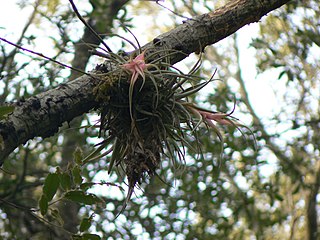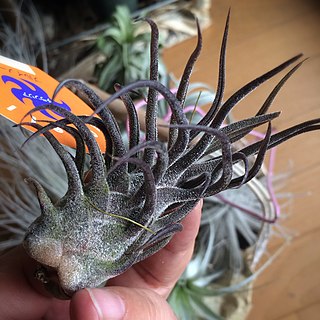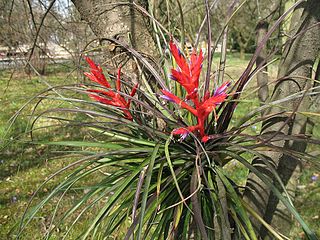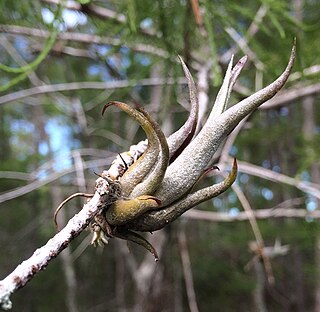
The Bromeliaceae is a family of monocot flowering plants of 75 genera and around 3590 known species native mainly to the tropical Americas, with several species found in the American subtropics and one in tropical west Africa, Pitcairnia feliciana.

Spanish moss is an epiphytic flowering plant that often grows upon large trees in tropical and subtropical climates. It is native to much of Mexico, Bermuda, the Bahamas, Central America, South America, the Southern United States, and West Indies. It has been naturalized in Queensland (Australia). It is known as "grandpa's beard" in French Polynesia.

Tillandsia caput-medusae is a species of flowering plant in the bromeliad family, Bromeliaceae, subfamily Tillandsioideae. Common names include octopus plant and medusa's head. An epiphyte native to Central America and Mexico, T. caput-medusae is a commonly cultivated bromeliad species. The thick, channeled, tapering and twisting leaves are up to 25 cm (9.8 in) long and are covered in fine gray hairs. The rosette of leaves arise from an inflated pseudobulb. Pups are produced after blooming, as is usual with most Tillandsia species.

Tillandsia intermedia is a species in the genus Tillandsia. The species is endemic to western Mexico, reported from Guerrero, Sinaloa, and Jalisco.

Tillandsia balbisiana, common name northern needleleaf, is a species of bromeliad in the genus Tillandsia. This species in native to Mexico, Central America, Colombia, Venezuela, the West Indies, and Florida.

Tillandsia erubescens is a species of epiphytic plants of the genus Tillandsia. This species is endemic to Mexico, found over much of the country from Chihuahua to Oaxaca.

Tillandsia imperialis is an epiphytic species in the genus Tillandsia. This species is endemic to Mexico, specifically the states Hidalgo, Oaxaca, Puebla, Querétaro, and Veracruz, at elevations ranging from 800 to 2,600 meters. Its distribution is generally on the eastern portion of the eastern Sierra Madre Mountains and the eastern portion of the Trans-Mexican Volcanic Belt. This species is primarily epiphytic to the branches and holes of the tree species Pinus patula and Quercus laurina, or on lianas of the same trees, in moist cloud forests. This bromeliad prefers moist conditions and does not tolerate extended periods of drought or low humidity.
Tillandsia ulrici is a species of Bromeliad in the genus Tillandsia. This species is endemic to Mexico.
Tillandsia violacea is a species of epiphytic flowering plant in the Bromeliaceae family. It is endemic to Mexico, particularly to the Central Mexican Plateau. This species' habitat is at elevations between 600 and 3,100 meters, and is epiphytic to large trees in humid temperate forests, primarily the species abies religiosa, quercus rugosa, and quercus laurina. In particular, it is a common epiphyte of the temperate pine forests of Hidalgo state, including El Chico National Park. Its range extends to the states of Guerrero, Jalisco, state of Mexico, Michoacán, Morelos, Oaxaca, and Veracruz. Due to its high-elevation habitat, this bromeliad species has tolerance to sub-freezing conditions.

Tillandsia pruinosa, is a species of flowering plant in the Bromeliaceae family. It is commonly known as the fuzzywuzzy airplant. This species is native to northern South America, Central America, southern Mexico, the West Indies and Florida.

Tillandsia chlorophylla is a species of flowering plant in the genus Tillandsia. This species is native to Belize, Guatemala, and southern Mexico.

Tillandsia fasciculata, commonly known as the giant airplant or cardinal airplant, is a species of bromeliad that is native to Central America, Mexico, the West Indies, northern South America, and the southeastern United States. Within the United States, this airplant is at risk of extirpation from the Mexican bromeliad weevil, Metamasius callizona.
Tillandsia festucoides, commonly known as the fescue airplant, is a species of bromeliad that is native to the Greater Antilles, Mexico, the Cayman Islands, and Central America.
Tillandsia flexuosa, the twisted airplant, is a species of bromeliad in the genus Tillandsia. This species is native to Central America, southeastern Mexico, northern South America and the United States (Florida).

Tillandsia paucifolia, the potbelly airplant, is a species of bromeliad in the genus Tillandsia. This species is native to Central America, central and southern Mexico, Venezuela, Colombia, the West Indies, and Florida.
Tillandsia pseudobaileyi is a species in the genus Tillandsia. This species is native to Mexico, Guatemala, El Salvador, Honduras, and Nicaragua.

Tillandsia punctulata is a species of bromeliad in the genus Tillandsia. This species is native to Central America and Mexico.

Tillandsia schiedeana is a species in the genus Tillandsia. It was named for the collector Schiede. As an epiphyte it is found "growing in open tropical forests, and saxicolous, growing on cacti and burseras on steep dry slopes in semiarid regions in Mexico, Central America, West Indies, Venezuela, and Colombia at elevations of 750 to 5,500 feet."

Tillandsia utriculata, commonly known as the spreading airplant or the giant airplant, is a species of bromeliad that is native to Florida and Georgia in the United States, the Caribbean, southern and eastern Mexico, Central America, and Venezuela.

Margery Claire Carlson was an American botanist and a professor at Northwestern University. After earning a Ph.D. in botany and becoming the first full-time female professor at Northwestern, she went on a number of international scientific expeditions to Central America in order to collect plant specimens and find new species. Her relationship as a research assistant at the Field Museum of Natural History meant that a majority of her plant collection was donated to the museum and a special botany collection was created for her there. Carlson had a long history of involvement in the conservation movement and was honored with multiple awards, along with a nature preserve being named after her.














